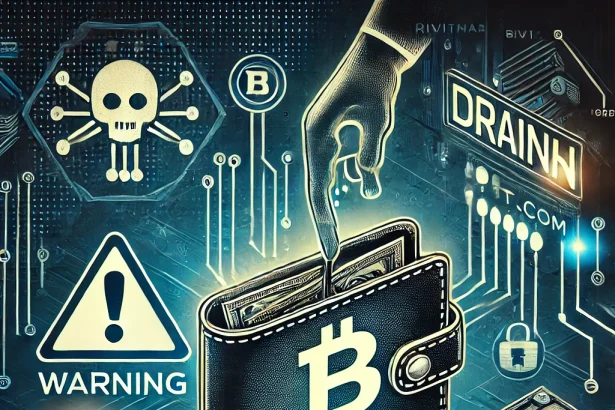The SOON NFT Mint scam is a deceptive phishing campaign targeting cryptocurrency users by impersonating the legitimate SOON blockchain platform. It lures victims with promises of exclusive NFT airdrops, only to drain their digital wallets through malicious smart contracts. This scam is part of a growing trend of fraudulent NFT minting sites designed to exploit unsuspecting users.
Overview of the SOON NFT Mint Scam
The fraudulent website, hosted at airdrop.soonetwork[.]org, mimics the official SOON platform (soo.network) to deceive users into connecting their cryptocurrency wallets. Once connected, the site executes a crypto drainer—a malicious tool that automatically transfers digital assets from the victim’s wallet to the scammer’s. These transactions are irreversible, leading to permanent financial loss.
This scam is particularly dangerous due to its convincing impersonation of a legitimate platform and the irreversible nature of cryptocurrency transactions. Users are advised to exercise extreme caution and verify the authenticity of NFT minting events before participating.
Threat Summary
| Attribute | Details |
|---|---|
| Threat Type | Phishing, Scam, Social Engineering, Cryptocurrency Drainer |
| Fake Claim | Exclusive NFT minting event on the SOON platform |
| Disguise | Mimics the legitimate SOON blockchain platform |
| Associated Domain | airdrop.soonetwork[.]org |
| Detection Names | alphaMountain.ai (Phishing), CRDF (Malicious), CyRadar (Phishing), Sophos (Phishing), Trustwave (Phishing) |
| Symptoms of Infection | Unauthorized transactions, loss of cryptocurrency assets |
| Damage | Permanent financial loss due to drained crypto wallets |
| Distribution Methods | Phishing emails, fake social media profiles, compromised websites |
| Danger Level | High |
| Removal Tool | SpyHunter |
In-Depth Analysis
How Did I Get Infected?
Victims typically encounter the scam through phishing emails, social media messages, or compromised websites promoting the fake NFT minting event. The scam leverages urgency and exclusivity to entice users into connecting their cryptocurrency wallets to the fraudulent site.
What Does It Do?
Upon connecting a wallet, the site executes a smart contract that grants the scammer access to the user’s funds. The crypto drainer then automatically transfers assets from the victim’s wallet to the attacker’s, leaving no opportunity for recovery.
Should You Be Worried?
Absolutely. The SOON NFT Mint scam is a sophisticated operation that can result in significant financial loss. Given the irreversible nature of cryptocurrency transactions, victims have no recourse once their funds are stolen. It’s crucial to remain vigilant and skeptical of unsolicited NFT offers, especially those requiring wallet connections.
Eliminating Crypto Scam Threats
Step 1: Identify and Report the Scam
- Gather evidence (screenshots, emails, transaction IDs).
- Report the fraud to:
- Your crypto exchange (Binance, Coinbase, Kraken, etc.).
- Law enforcement agencies like the FBI’s IC3 (ic3.gov) or the SEC (sec.gov/tcr).
- The Federal Trade Commission (reportfraud.ftc.gov).
- Blockchain explorers (like Etherscan) to check your wallet transactions.
Step 2: Uninstall Suspicious Software & Apps
- On Windows: Open Control Panel > Programs & Features → Find & Uninstall suspicious programs.
- On macOS:Go to Finder > Applications → Drag unwanted apps to Trash.
- On Android & iOS: Go to Settings > Apps → Uninstall fake crypto wallets or trading apps.
Step 3: Remove Malicious Browser Extensions
- Google Chrome:
- Open
chrome://extensions/ - Remove any unfamiliar or crypto-related suspicious add-ons.
- Open
- Firefox / Edge / Safari:
- Go to browser settings > extensions → Delete suspicious ones.
- Clear browser cache & cookies:
- Open browser settings → Privacy → Clear browsing data.
Step 4: Secure Your Accounts & Wallets
Change passwords immediately for:
- Crypto wallets
- Exchanges
- Email & social media
Enable Two-Factor Authentication (2FA):
- Use Google Authenticator, YubiKey, or Authy.
Move remaining funds to a secure wallet:
- Use a hardware wallet (Ledger, Trezor) instead of online wallets.
Step 5: Scan for Hidden Malware & Keyloggers
Your system may still have spyware, tracking your keystrokes or redirecting you to scam sites. A deep scan is essentialto detect and remove threats.
⏳ For a thorough malware check, use SpyHunter. (See Method 2 below.)
Automatic Removal with SpyHunter
If you suspect hidden malware, SpyHunter can detect and remove crypto scam-related malware, trojans, and browser hijackers.
Step 1: Download SpyHunter
Follow SpyHunter installation instructions here: SpyHunter Download Guide
Step 2: Install and Run SpyHunter
- Run the SpyHunter installer.
- Follow the on-screen installation steps.
- Launch SpyHunter after installation.
Step 3: Perform a Full Malware Scan
- Click “Start Scan Now”.
- Let SpyHunter scan for:
- Crypto-stealing malware
- Browser hijackers redirecting to fake exchanges
- Phishing-related spyware
Step 4: Remove All Detected Threats
- Click “Fix Threats” to eliminate malicious programs.
- Restart your system to complete the cleanup.
Step 5: Enable Real-Time Protection for Future Security
Activate SpyHunter’s real-time protection to:
- Block phishing & scam websites
- Prevent future infections
- Monitor system vulnerabilities
Proactive Prevention: How to Avoid Crypto Scams
- NEVER share your private keys or seed phrases – even with “support teams.”
- Always verify URLs before logging in to exchanges.
- Use only official wallet apps from trusted sources.
- Ignore unsolicited investment offers via Telegram, Discord, and social media.
- Check for HTTPS & security certificates before entering login details.
- Regularly scan your device for hidden malware and spyware.
- Store crypto in a hardware wallet (Ledger, Trezor) rather than online wallets.
Conclusion
The SOON NFT Mint scam exemplifies the growing threat of phishing attacks in the cryptocurrency space. By impersonating legitimate platforms and exploiting the excitement around NFTs, scammers are successfully draining users' wallets. To protect yourself, always verify the authenticity of NFT minting events and avoid connecting your wallet to untrusted sources. If you suspect your system may be compromised, consider using SpyHunter to detect and remove potential threats.




